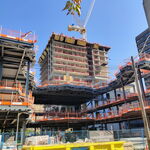It's far more complicated than that, and I'll show you why. Eglinton is not Yonge or Bloor, it is being built after 4 different subway lines (not routes, lines. Line 1 is one route, but runs along the Yonge line, and the University-Spadina Line) were built in this city. Back in the day, the majority of people had to transfer to the 2 main corridors of the city (bloor and Yonge) regardless of where they were in the city. These days, there are subways on Yonge, University-Spadina, Bloor, and Sheppard. People have many choices for getting to the subway, and will often ride a bus past Eglinton in order to get to either Sheppard or Bloor, or away from Eglinton to get to Yonge or Kennedy.
When the crosstown opens, things will dramatically change, there will be a brand new rapid transit line on Eglinton, and for the majority of people that currently do not use the Eglinton Corridor (especially the Eglinton East corridor) as a gateway to the subway will switch their commute to head to Eglinton. This means that the actual ridership usage of the line will be far greater than the current capacity of the corridor. In terms of the number of buses counted outside of Eglinton Station, both Eglinton East and Eglinton west see about 1000 buses per day. While the 34 sees a bit more than half the riders of the 32, we have to remember that there are other buses that run on Eglinton East, especially prior to Don Mills. These being the 51, 54, and 56A. A summary of the bus totals can be seen below:
View attachment 192904
NOTE: the 32 sees abnormally high bus counts because of the way the TTC counts buses at Eglinton West Station and the fact that the 51, 54, and 56A have better evening service overall. The totals are correct, and ultimately this is pretty irrelevant to the main point. However, when we consider the general traffic on Eglinton today solely based on the number of buses that enter and Exit Eglinton station, we can assume that ridership is pretty equal between the East Half and the West Half of the city.
Sure, the 34A looks like it sees relatively pathetic service by todays standards, and that's fine, but we also have to consider every other bus route that crosses the Eglinton Corridor in the East:
View attachment 192907
I have summarized the bus tally's for the corridor east of Don Mills Road. It's actually much higher when you consider the section between Yonge and Don Mills, but the east portion is where we're focussing:
View attachment 192911
Ultimately, there are close to 900 buses that intersect with the surface section of the Eglinton East corridor. These 8 bus routes will obviously not see all their traffic diverted to Eglinton Avenue, but it's safe to say that a good portion (probably a bit more than half) will choose to use Eglinton over Bloor or Sheppard when the Crosstown Opens. We can safely assume that approximately 450 more buses worth of people will use the eastern portion of the Eglinton Corridor. If we're looking at morning peak loads, that's the equivalent of 34 more busloads of people per hour on the Eglinton East corridor, or close to 2K additional passengers per hour in the peak direction of travel, 4K passengers per hour in the peak direction if all passengers choose to transfer at the Eglinton corridor. This would all be on the opening day, not 10 years from the opening of the crosstown, and just on a section 1/3 that of the entire crosstown.





